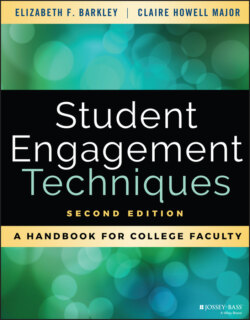Читать книгу Student Engagement Techniques - Elizabeth F. Barkley - Страница 19
Documented Outcomes of Student Engagement
ОглавлениеResearchers have demonstrated that engaging students in the learning process is related to increases in their academic achievement. As Coates (2005) points out, the student engagement research often is concerned with “the extent to which students are engaging in a range of educational activities that research has shown as likely to lead to high quality learning” (p. 26). Several researchers have indeed documented that increased levels of student engagement are positively related to increased student learning (see, e.g., Carini, Kuh, & Klein, 2006; Kuh, Kinzie, Buckley, Bridges, & Hayek, 2007; Glanville & Wildhagen, 2007). Pascarella and Terenzini's (2005, 2016) systematic review of the literature, for example, finds that “a substantial amount of both experimental and correlation evidence suggests that active student involvement in learning has a positive impact on the acquisition of course content” (2005, p. 101). In addition to improved learning outcomes, student engagement has been linked to other aspects of academic achievement, such as improved retention and persistence (see, e.g., Cruce, Wolniak, Seifert, & Pascarella, 2006; Krause, 2005).
Moreover, student engagement has been shown to help all learners to succeed, and thus it has an important social justice function. As Kuh (2009) argues, “Engagement has compensatory effects on grades and persistence for students who most need a boost to performance because they are not adequately prepared academically when they start college” (p. 685). He goes on to state that “engaging in educationally purposeful activities helps to level the playing field, especially for students from low-income family backgrounds and others who have been historically underserved” (689). The evidence is clear, according to Harper and Quaye (2009), who similarly state:
We are persuaded by a large volume of empirical evidence that confirms that strategizing ways to increase the engagement of various student populations, especially those for whom engagement is known to be problematic, is a worthwhile endeavor. The gains and outcomes are too robust to leave to chance, and social justice is unlikely to ensue if some students come to enjoy the beneficial by-products of engagement but others do not. (p. 3)
Thus, the costs of not striving for engagement for all are simply too high. It is imperative to seek to engage all students in their learning.
While combined motivation and active learning promote basic student engagement and improve learning outcomes for all students, some teachers are pushing for even more: They want students to be truly transformed by their educational experiences. Although any learning, by definition, results in some level of change, transformative learning is deep and thorough change. Cranton (2006) defines transformative learning as “a process by which previously uncritically assimilated assumptions, beliefs, values, and perspectives are questioned and thereby become more open, permeable, and better justified” (p. vi). It requires learners “to examine problematic frames of reference to make them more inclusive, discriminating, open, reflective, and able to change” and can be “provoked by a single event … or it can take place gradually and cumulatively over time” (p. 36).
Transformative learning occurs when students are challenged intensely, creating the kind of growth described by Perry's (1998) upper levels of intellectual and ethical development. In Perry's observations, most freshmen enter college as dualists, believing that there are clear, objective, right/wrong answers. One of the goals of a college education is to help students move beyond dualistic thinking to more complex stages as they learn to deal with uncertainty and relativism. As experiences challenge their thinking, students begin to see that truth is contextual and relative, and, since there is not a single correct answer, may think something along the lines of “everyone has a right to their own opinion.” Eventually they recognize that there may be multiple answers to a question, but not all answers are equal, and specific criteria such as empirical evidence and logical consistency can help them evaluate the usefulness and validity of knowledge claims.
In Perry's (1998) fourth and final stage, students come to recognize that they must make individual choices that require both objective analysis and personal values. As students' thinking matures to this level of sophistication, it is truly transformative. Interestingly, Bowen (2005) observes that students often resist teachers' attempts to promote transformative learning precisely because it “necessarily threatens the student's current identity and worldview,” and he cites a study at an elite liberal arts college revealing that the majority of students did not want to participate in a discussion until they felt well prepared to defend their already firmly held views (Trosset, 1998, in Bowen, 2005). Some teachers consider transformative learning to be an element of engaged learning, but it may not be so much a required element as much as the result of either sustained engagement or engagement that has achieved a higher level of personal intensity.
